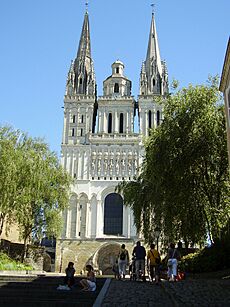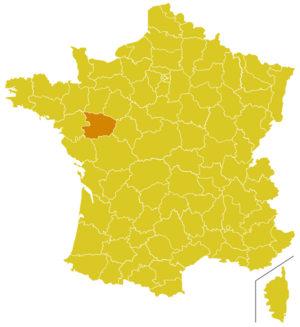Roman Catholic Diocese of Angers facts for kids
Quick facts for kids Diocese of AngersDioecesis Andegavensis Diocèse d'Angers |
|
|---|---|

Angers Cathedral
|
|
| Location | |
| Country | France |
| Ecclesiastical province | Rennes |
| Metropolitan | Archdiocese of Rennes, Dol, and Saint-Malo |
| Statistics | |
| Area | 7,166 km2 (2,767 sq mi) |
| Population - Total - Catholics |
(as of 2012) 783,000 566,000 (72.3%) |
| Parishes | 85 |
| Information | |
| Denomination | Roman Catholic |
| Rite | Roman Rite |
| Established | 372 |
| Cathedral | Cathedral of St. Maurice in Angers |
| Patron saint | Saint Maurice |
| Current leadership | |
| Pope | Francis |
| Bishop | Emmanuel Delmas |
| Metropolitan Archbishop | Pierre d'Ornellas |
| Map | |
 |
|
| Website | |
| Website of the Diocese | |
The Diocese of Angers (Latin: Dioecesis Andegavensis; French: Diocèse d'Angers) is a special area of the Catholic Church in France. It's like a region where a bishop leads the local Catholic community. The main church for this diocese is the beautiful Angers Cathedral in the city of Angers. The area it covers is the entire Maine-et-Loire department.
For a long time, the Diocese of Angers was connected to the Roman Catholic Archdiocese of Tours. This meant it was part of a larger church region. Today, it is part of the Roman Catholic Archdiocese of Rennes, Dol, and Saint-Malo.
Contents
History of the Diocese
The first known bishop of Angers was Defensor. He was present in the year 372 when a new bishop was chosen for Tours. Defensor strongly disagreed with the choice of Martin of Tours. Stories about an earlier bishop named Auxilius are not supported by older local traditions.
Early Bishops and Important Figures
Many important people have been part of the Diocese of Angers.
- Maurilius was a student of Martin. He worked hard against idolatry (worshipping idols) and died in 427.
- Thalassius became bishop in 453. He created a collection of canon law, which are rules for the church.
- Albinus was a bishop in the sixth century.
- Licinius was a former count who became bishop in the early seventh century.
There is a story that Renatus was a bishop around 450. The story says Maurilius brought him back to life. However, this story comes from a later writing in 905 and might not be true.
Bishops in Modern Times
Here are some notable bishops from more recent history:
- Cardinal de la Balue (1467) was a cardinal who was imprisoned for his talks with Charles the Bold.
- Henri Arnauld (1649–1693) was known for his support of a religious movement called Jansenism.
- Charles-Émile Freppel (1870–1891) was a member of the French government. He strongly defended Catholic interests.
- François-Désiré Mathieu (1893–1896) became a cardinal and was a member of the French Academy.
Churches and Monasteries
Angers Cathedral is a grand church dedicated to Maurice. It was built in the twelfth century. It shows a special style of architecture from the Angers region. During the Middle Ages, Angers was a busy city with many monasteries.
- The Abbey of St. Aubin was founded by King Childebert I.
- The Abbey of St. Serge was founded by Clovis II.
- St. Julien, St. Nicholas, and Ronceray abbeys were founded by Count Foulques Nerra.
- All Saints' Abbey is a beautiful building from the twelfth century.
In 1219, Pope Callixtus II visited Angers to attend a special ceremony at Ronceray Abbey. The Diocese of Angers also includes Fontevrault. This abbey was founded in the late eleventh century but did not survive the French Revolution. The ruins of St. Maur remind us of another large Benedictine abbey.
Education and Other Important Events
In 1244, a university was started in Angers. It taught canon law (church law) and civil law (regular law). Later, in 1432, new subjects like theology, medicine, and art were added. This university continued until the French Revolution. After a law in 1875 allowed more freedom in education, Angers once again became home to a Catholic university.
The Congregation of the Good Shepherd (Bon Pasteur) is a religious group with centers all over the world. Its main house is in Angers, established in 1835.
A person named Berengarius was an archdeacon in Angers around 1039. He had different ideas about the Holy Eucharist, which were not accepted by the church. For a while, Bishop Eusebius Bruno protected him. Bernier, who played a big part in the wars of La Vendée and in the talks that led to the Concordat (an agreement between the church and the state), was a priest in Angers.
Bishops of Angers
Here is a list of the bishops who have led the Diocese of Angers over the centuries.
Bishops to 1000
- Defensor (around 372)
- Maurilius (423–453)
- Thalasse (or Thalaise) (453–462)
- Andulphe (−529)
- Aubin (Albinus) (529–550)
- Audovée (581–592)
- Lezin (592–610)
- Mainboeuf (610–660)
- Dodon (837–880)
- Rainon (881–906)
- Rothard (910)
- Renaud I (920)
- Hervé (929–942)
- Aimon (943–966)?
- Nefingus (966–973)
- Renaud II. (973–1006)
Bishops from 1000 to 1300
- Hubert of Vendôme (1006–1047)
- Eusebius Bruno (1047–1081)
- Gottfried of Tours (1081–1093)
- Gottfried of Mayenne (1093–1101)
- Renaud de Martigné (1102–1125)
- Ulger (1125–1148)
- Normand de Doué (1148–1153)
- Mathieu de Loudun (1156–1162)
- Geoffroy La Mouche (1162–1177)
- Raoul I. de Beaumont (1177–1197)
- Guillaume I. de Chemillé (1197–1202)
- Guillaume II. de Beaumont (1203–1240)
- Michel I. Villoiseau (1240–1260)
- Nicolas Gellent (1260–1291)
- Guillaume III. Le Maire (1291–1317)
Bishops from 1300 to 1500
- Hugues Odard (1317–1323)
- Foulques de Mathefelon (1324–1355)
- Raoul II. de Machecoul (1356–1358)
- Guillaume IV. Turpin de Cressé (1358–1371)
- Milon de Dormans (1371–1373)
- Hardouin de Bueil (1374–1439)
- Jean I. Michel (1439–1447)
- Jean II. de Beauveau (1447–1467)
- Jean de La Balue (1467–1476)
- Jean II de Beauveau (1476–1479) (administrator)
- Auger de Brie (1479–1480) (administrator)
- Jean de La Balue (1480–1491)
- Jean IV. de Rély (1491–1499)
- François de Rohan (1499–1532)
Bishops from 1500 to 1800
- Jean Olivier (1532–1540)
- Gabriel Bouvery (1540–1572)
- Guillaume Ruzé (1572–1587)
- Charles Miron (1588–1616)
- Guillaume Fouquet de la Varenne (1616–1621)
- Charles Miron (1622–1627)
- Claude de Rueil (1628–1649)
- Henri Arnauld (1650–1692)
- Michel Le Peletier (1692–1706)
- Michel Poncet de la Rivière (1706–1730)
- Jean de Vaugirault (1731–1758)
- Jacques de Grasse (1758–1782)
- Michel Cauet (1782–1802)
- Hugues Pelletier (1791–1793)
Bishops from 1800 to Today
- Charles Montault des Isles (1802–1839)
- Louis-Robert Paysant (1839–1841)
- Guillaume-Laurent-Louis Angebault (1842–1869)
- Charles-Emile Freppel (1869–1891)
- François-Désiré Mathieu (1893–1896) (also Archbishop of Toulouse)
- Louis-Jules Baron (1896–1898)
- Joseph Rumeau (1898–1940)
- Jean-Camille Costes (1940–1950)
- Henri-Alexandre Chappoulie (1950–1959)
- Pierre Veuillot (1959–1961) (also Archbishop of Paris)
- Henri-Louis-Marie Mazerat (1961–1974)
- Jean Pierre Marie Orchampt (1974–2000)
- Jean-Louis Bruguès, O.P. (2000–2007)
- Emmanuel Delmas (since 2008) (fr)
See also
- Catholic Church in France
- List of Catholic dioceses in France

